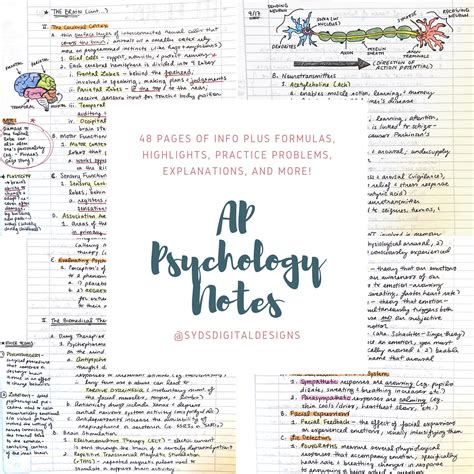Skip to content

Unit 1: Introduction to Psychology
History and Approaches to Psychology
- 19th-century Wilhelm Wundt: First psychology laboratory, focusing on introspective methods
- Early 20th-century: Behaviorism (Watson, Skinner) emphasized observable behaviors
- Humanistic psychology (Maslow, Rogers) highlighted subjective experiences and personal growth
- Cognitive psychology (Piaget, Chomsky) investigated mental processes and cognition
Methods of Research in Psychology
- Descriptive methods: Observation, surveys, case studies
- Correlational methods: Examine relationships between variables without establishing causality
- Experimental methods: Control variables and manipulate independent variables to determine causation
Unit 2: Biological Bases of Behavior
Nervous System and Neurotransmitters
- Neuron: Basic unit of the nervous system, responsible for transmitting signals
- Neurotransmitters: Chemical messengers that facilitate communication between neurons
- Dopamine: Involved in reward, motivation, and attention
- Serotonin: Regulates mood, sleep, and appetite
Brain Structure and Function
- Cerebral cortex: Outer layer responsible for higher-level cognitive functions
- Limbic system: Involved in emotions, memory, and motivation
- Hypothalamus: Regulates body temperature, hunger, and thirst
Unit 3: Sensation and Perception
Sensory Systems
- Vision: Light waves detected by the eyes and processed by the brain
- Hearing: Sound waves detected by the ears and processed by the auditory cortex
- Somatosensation: Touch, pain, temperature, and body position
- Olfaction and gustation: Chemical senses for smell and taste
Perception
- Process of interpreting sensory information
- Gestalt principles: Perceptual organization based on principles of proximity, similarity, and closure
Unit 4: States of Consciousness
Sleep
- Stages of sleep: REM (rapid eye movement) and non-REM sleep
- Functions of sleep: Memory consolidation, restoration of physical functions
- Sleep disorders: Insomnia, sleep apnea, narcolepsy
Dreams
- Occur during REM sleep
- Psychoanalytic theory: Manifest content (dream images) reflects underlying latent content (unconscious desires)
Hypnosis
- Altered state of consciousness characterized by increased suggestibility
- Applications in therapy and pain management
Unit 5: Learning
Classical Conditioning
- Association between a neutral stimulus and a biologically significant stimulus
- Ivan Pavlov’s dog experiments: Conditioned response of salivating to the sound of a bell
Operant Conditioning
- Reinforcement and punishment shape behavior
- Positive reinforcement: Pleasant consequence increases behavior
- Negative reinforcement: Removal of an unpleasant experience increases behavior
Cognitive Learning
- Learning through mental representations and processes
- Observational learning: Imitation of observed behaviors
- Latent learning: Learning without apparent reinforcement or punishment
Unit 6: Memory
Types of Memory
- Sensory memory: Temporary storage of sensory information
- Short-term memory: Limited capacity memory system for a few seconds
- Long-term memory: Stores information indefinitely
Forgetting
- Factors influencing forgetting: Decay, interference, retrieval failure
Memory Enhancement Techniques
- Rehearsal: Repeating information
- Spaced repetition: Reviewing information at increasing intervals
- Elaboration: Connecting new information to existing knowledge
Unit 7: Thinking and Language
Problem-Solving
- Process of finding solutions to problems
- Divergent thinking: Generating multiple potential solutions
- Convergent thinking: Narrowing down to the best solution
Decision-Making
- Process of selecting the best course of action
- Heuristics: Mental shortcuts used in decision-making
- Biases: Cognitive errors that can interfere with decision-making
Language
- System of symbols used for communication
- Acquisition of language: Children acquire language through exposure and reinforcement
Unit 8: Motivation and Emotion
Motivation
- Internal factors that drive behavior
- Maslow’s hierarchy of needs: Physiological, safety, belongingness, esteem, self-actualization
- Extrinsic vs. intrinsic motivation
Emotion
- Complex physiological and psychological response to stimuli
- Six basic emotions: Happiness, sadness, anger, fear, surprise, disgust
Theories of Emotion
- James-Lange theory: Emotion follows physiological arousal
- Cannon-Bard theory: Emotion and physiological arousal occur simultaneously
Unit 9: Development
Prenatal Development
- Stages of prenatal development: Germinal, embryonic, fetal
- Factors influencing prenatal development: Genetics, environment, nutrition
Childhood Development
- Cognitive development: Piaget’s stages of cognitive development
- Physical development: Motor skills, growth spurts
- Social and emotional development: Attachment, peer relationships
Adolescent Development
- Physical changes: Puberty, growth spurts
- Cognitive development: Formal operational stage
- Psychosocial development: Identity formation, independence
Unit 10: Personality
Theories of Personality
- Psychoanalytic theory (Freud): Personality based on unconscious childhood experiences
- Humanistic theory (Maslow, Rogers): Personality emphasizes personal growth and potential
- Trait theory (Cattell, Eysenck): Personality based on stable traits
Personality Assessment
- Interviews, observations, self-report measures
- Big Five Personality Traits: Openness, conscientiousness, extraversion, agreeableness, neuroticism
Unit 11: Abnormal Psychology
Definition and Classification of Abnormal Behavior
- Criteria for abnormal behavior: Statistical rarity, deviation from social norms, personal distress
- DSM-5: Diagnostic and Statistical Manual of Mental Disorders
Types of Psychological Disorders
- Anxiety disorders: Phobias, generalized anxiety disorder, panic disorder
- Mood disorders: Depression, bipolar disorder
- Schizophrenia: Characterized by delusions, hallucinations, and disorganized speech
Treatment of Psychological Disorders
- Psychotherapy: Talk therapy to address underlying issues
- Psychopharmacology: Medication to alleviate symptoms
